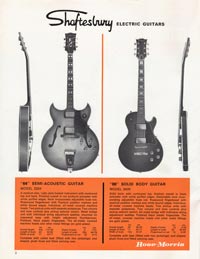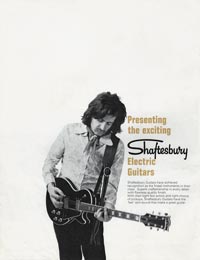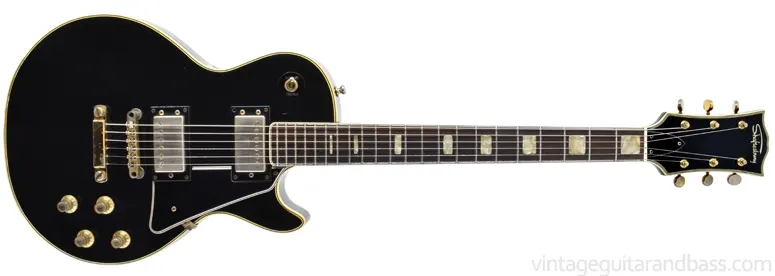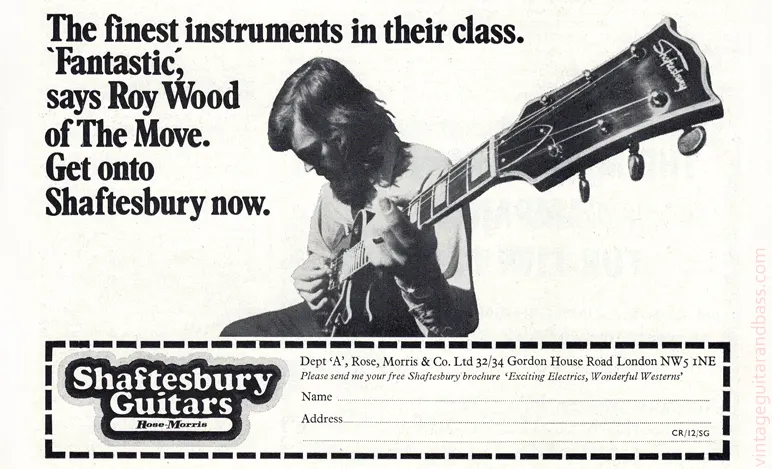
The Gibson Les Paul was a seriously desirable guitar in the late 1960s. Highly revered musicians like Jeff Beck, Eric Clapton and Peter Green were all seen playing Les Pauls, yet Gibson had discontinued production by 1961. So as the '60s ended, demand was high, yet availability low. Gibson had reissued the Les Paul in 1968, but, naturally these were hugely expensive. The gap in the market was such, that just about every distributor needed an affordable Les Paul - model 3400 (or "00" as it was often referred) was Rose-Morris's version of the Les Paul Custom (black body, gold hardware, block inlays, open-book headstock profile) sold under their mid-priced Shaftesbury brand. It launched in the UK in the Summer of 1969 with a list price of price was £69 10s (see it on display at the 1969 British Musical Instrument trade fair). At the same time, Gibson UK-distributor, Selmer were selling the Les Paul Custom for 245 gns (£257 5s) - almost four times the price - though by 1971 the price of the Gibson had risen to £403. But the Shaftesbury, despite it's looks, wasn't a Gibson. It had no set neck, carved maple body cap, or nitrocellulose finish, and the pickups were not Gibson patent number humbuckers. But it wasn't a bad guitar, and sold pretty well in the early 1970s.


Model 3400 was described as follows in the 1970 Rose-Morris 'Exciting Electrics • Wonderful Westerns • Celebrated Classics' guitar catalogue
Solid body with contoured top, finished overall in black polyester with white purfled edges. Detachable neck incorporating adjustable truss rod. Rosewood fingerboard with Pearloid position markers and white bound edges. Individual, all-metal covered machine heads. Two pickup units with separate polepieces. Two volume and tone controls plus pick up selector switch. All–metal bridge with individual string adjustment saddles. Polished black plastic finger plate. The all-metal covered machine heads and other metal fittings are gold plated

Model 3400 in the 1971 Rose-Morris catalogue
The Shaftesbury 'Les Paul' was produced by Japanese manufacturer Matsumoku who were rapidly building a reputation for quality workmanship - this was, after all, the same plant building the new Japanese Epiphone line, and would go onto produce Madeira guitars for Guild and Dorado guitars for Gretsch. Many of their guitars shared features with each other: bodies, hardware etc; and almost identical (save branding) Matsumoku Les Pauls were produced under various marques worldwide: Arbiter, Aria (5522), Eros, Jedson (Jet 4444), Kimbara, Shaftesbury (3400), Univox (U1982 "Rhythm and Blues") etc. Examples of some of these were manufactured by different companies, in different plants: not all Univox, Jedson or Eros 'Les Pauls' were made by Matsumoku for example. Look out!
Matsumoku 'Les Pauls' at least in the period 1970-1973 can be identified by certain features: 3-ply binding on body front and back; 3-ply bound neck, with 5-ply bound headstock; eight block inlay markers, starting at fret one; rounded fretboard at the body; end neckplate that reads "STEEL ADJUSTABLE NECK", "MADE IN JAPAN" (not always) and a seven digit serial number; metal capped bell knobs. Other hardware can vary to some extent.
The Shaftesbury 3400 had a nice inlaid headstock logo, but there is some variation over the course of 3400 production. The earliest (mostly 1969/70) examples had a larger logo than those from 1971 onwards. These early guitars (including the example pictured in the 1970 and 1971 Rose-Morris catalogues) have pickups with just two height adjustment screws - in early 1971 (give or take a month or two) this was changed to three; this allows the player to adjust pickup rake (angle) - a useful feature even Gibson did not experiment with until the late 1970s. Towards the mid-1970s the model was refined somewhat: hook-on tailpiece was replaced by the very similar bolt-through tailpiece, and the pickguard design changed also - compare the 1971 3400 with a 1973 3400 below. The pickups, although still Maxon humbuckers with the same basic construction, were modified somewhat: slightly taller with a wider pole piece spacing and a lower DC resistance most likely due to thicker gauge windings.

The following ad from the December 1973 issue of UK music magazine Crescendo features Roy Wood of the Move / ELO. "Fantastic". The coupon allows you to order the 'Exciting Electrics Wonderful Westerns' brochure, shown above.

It seems that in recent times, after many years absence, Shaftesbury guitars have been revived; though the new guitars are easily distinguishable from the older Japanese models, typically having a silk-screened logo and set-neck, and none of the Matsumoku features described above.
$799
£320
£250
£312
£333